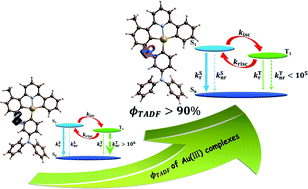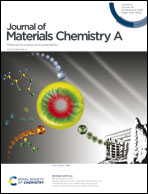A novel molecular descriptor for highly efficient (ϕTADF > 90%) transition metal TADF Au(iii) complexes†
Abstract
It is generally perceived that a fast reverse intersystem crossing rate of T1 → S1 (krisc) is crucial for efficient organic thermally activated delayed fluorescence (TADF) emitters. Herein, we demonstrate the non-radiative decay rate of T1 → S0 (kTnr) for transition metal complexes that is even more important. We calculated the interconversion rates among S0, S1 and T1 states for two Au(III)–TADF complexes with triphenylamine (TPA) as a donor moiety but with quite different quantum efficiencies: one with a moderate efficiency of 79% and the other with a high efficiency of 94%, and we found that the former has a much larger krisc (∼1010 s−1) than the latter (∼107 s−1). Such contradictions with the conventional picture are attributed to the relatively large kTnr (∼106 s−1) for the former, leading to an overall lower quantum efficiency. Thus, we propose a novel molecular design descriptor (the triplet non-radiative decay rate kTnr) for highly efficient transition metal TADF emitters. Further, we find that tetradentate ligand scaffolds with 5-5-6 membered chelate rings could reduce kTnr to <105 s−1 for Au(III)–TADF complexes, thereby achieving quantum efficiencies above 90%. Based on this theoretical guideline, we have proposed nine newly designed Au(III) complexes and predicted their high TADF efficiency.



 Please wait while we load your content...
Please wait while we load your content...